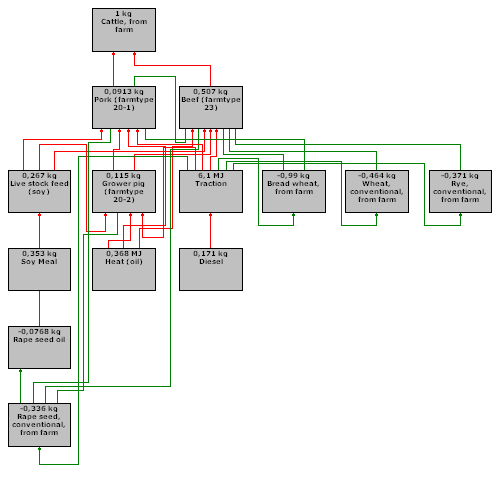Living cattle ex farm
(Levende kvæg ab landbrug)
Old dairy cows and bull calves are produced as a side product to milk production in Denmark and the cattle meat production is determined by milk production, which is in turn determined by public regulations (quotas), see Andersen and Jensen (2003). Hence, a marginal demand for cattle ex farm does not influence the cattle production processes but rater the products they substitute. It has been assumed (Weidema, 2003) that expensive cattle meat (> 101 DKK; about 51% of the cattle meat) displaces imported cattle meat from extensive farms and that cheap cattle meat (< 101 DKK; about 49% of the cattle meat) displaces pork meat (see prices in cattle meat) and the environmental impacts associated with a demand for one kg living cattle equals 0.51 kg living cattle from extensive farms abroad and 0.49 kg living pig from the marginal Danish pig farm.
The main processes influenced a marginal demand for living cattle ex farm are shown in the figure below. Cattle meat production in Denmark (Farm type 23) represents cattle meat production at extensive farms abroad.
|
|
| Figure 1: Market based product chain diagram for living cattle ex farm covering the most important processes in terms of contribution to global warming. Boxes refer to production processes. Names of grey boxes refer to the main product of the processes. Red arrows represent material or energy transfer between two processes; green arrows represent saved material or energy transfer as a result of displacements; green lines represent displacements and red lines represent avoided displacements. Further details can be found in the LCA model. |
Cattle as well as pigs are fed with animal feed based on soy meal and a number of other ingredients. Soy oil is co-produced with soy meal and the soy oil displaces rapeseed oil (Weidema 2003). Rapeseed meal is co-produced with rapeseed oil explaining the displacements related to soy and rapeseed.
Bread wheat and a number of other products are produced at the cattle farm and the piggery farm. The environmental impacts associated with bread wheat production and other products have been eliminated by system expansion, explaining the green lines linked to "bread wheat from farm".
The table below shows potential environmental impacts associated with a marginal demand for living cattle ex farm in the present market situation with milk quotas1). All data are provided per kg of living cattle.
|
Impact category |
Unit | Conventional |
Organic |
|
Global warming |
g CO2-eq. | 11600 |
|
|
Acidification |
g SO2-eq. | 117 |
|
| Nutrient enrichment | g NO3-eq. | 988 | |
| Smog formation | g ethene eq. | 2.4 | |
| Land use | m2 year | 18 |
| Location in database: Material/ Food from primary sectors/agriculture/Cattle, from farm |
References
Jensen JD and Andersen M (2003). Marginale producenter af udvalgte landbrugsprodukter. FØI Working paper no. 08/2003 (in Danish).
Weidema B (2003). Market information in life cycle assessments. Technical report, Danish Environmental Protection Agency (Environmental Project no. 863).
-----------
1)
It
has been assumed
that cattle production in Denmark is determined
by the milk production also if the milk quotas are removed.
Thus, the
environmental impacts associated with cattle production are the same in an
envisioned market situation without milk quotas. The assumption has not been
documented.
